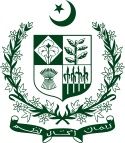
Back পাকিস্তানের সাধারণ নির্বাচন, ১৯৯৭ Bengali/Bangla Parlamentswahlen in Pakistan 1997 German Élections législatives pakistanaises de 1997 French Pemilihan umum Pakistan 1997 ID Парламентские выборы в Пакистане (1997) Russian پاکستان کے عام انتخابات 1997ء Urdu 第7屆巴基斯坦下議院選舉 ZH-YUE
| ||||||||||||||||||||||||||||
All 217 seats in the National Assembly 109 seats needed for a majority | ||||||||||||||||||||||||||||
|---|---|---|---|---|---|---|---|---|---|---|---|---|---|---|---|---|---|---|---|---|---|---|---|---|---|---|---|---|
| Turnout | 35.79% ( | |||||||||||||||||||||||||||
| ||||||||||||||||||||||||||||
 Map of Pakistan Showing National Assembly Cosntituencies and winning Parties | ||||||||||||||||||||||||||||
| ||||||||||||||||||||||||||||
 |
|---|
|
|
General elections were held in Pakistan on 3 February 1997 to elect the members of National Assembly. The elections were a fierce contest between Pakistan Peoples Party (PPP) led by pre-election Prime Minister Benazir Bhutto and the Pakistan Muslim League (N) led by Nawaz Sharif. Unlike the 1990 elections where Sharif won due to allegations of rigging, this time he benefited from the controversial death of Bhutto's brother Murtaza, a populist leader, a worsening economy, and alleged corruption cases against Bhutto's husband Asif Ali Zardari.
The elections took place after the previous PPP government was dismissed by President Farooq Leghari for matters of national security. Bhutto's government suffered with financial mismanagement, corruption charges, racial tensions in her native Sindh Province, issues with the judiciary, violations of the constitution, and intra-party and family feuds. After the PPP government was dismissed, a caretaker government was formed under the leadership of Malik Meraj Khalid.
The result was a landslide victory for the PML (N), which received most votes ever won by an opposition party at the time. This was the first time PML-N had won an election without being part of any alliance. Sharif subsequently became Prime Minister for a second non-consecutive term. The PPP meanwhile got wiped out, losing 71 seats and winning only 18 due to Bhutto's increasing unpopularity. Voter turnout was only 36.0%.[1]
- ^ Dieter Nohlen, Florian Grotz & Christof Hartmann (2001) Elections in Asia: A data handbook, Volume I, p680 ISBN 0-19-924958-X



